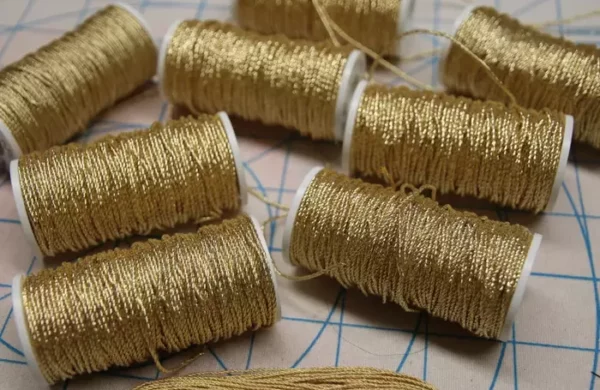
Gilt Twist goldwork threads, particularly in sizes No. 3 or No. 4 for outer edges and No. 1 1/2 or No. 2 for smaller areas, beautifully enhance goldwork appliques in embroidery. The choice of twist size depends on the design’s details and the width of the gold edge, ensuring a neat finish with one pass of stitching in pairs.
Like this:
Like Loading...
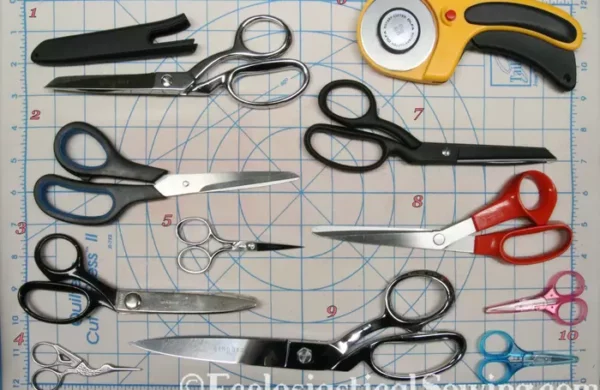
When it comes to selecting scissors, take some time to examine them carefully, try cutting with them or at least opening and closing them a few times. The mechanism should operate smoothly without sticking or feeling loose and sloppy. The blades should come together in a smooth motion. Be sure to read any information on the packaging about recommended care and sharpening instructions. And once you find a pair that feels good in your hand, enjoy and take good care of your investment
Like this:
Like Loading...

When making pastor or priest stoles in the Ecclesiastical Sewing workroom, there are always a few last-minute details to stitch up before completing that final press and sending a stole off to a new church home. These guidelines when you create your own stoles just like we do in the Ecclesiastical Sewing Studios, you will be well on your way to having a finely “polished” and finished pastor or priest stole.
Like this:
Like Loading...

Pastors and priests come in all sizes from petite to very tall, with many variations in between. Our standard 4 1/2-inch wide clergy stole style is 53 inches long before adding any tassels or trims. The 53 inches is measured from the Center Back neckline to the bottom edge of the stole. The stole length is perfect fit for people who are approximately 5’6″ to 5’11” tall. The 51-inch clergy stole is designed for people who are 5’5″ tall or shorter. The 55-inch stole works well for people who are 6′ tall and over. There are many different stole styles, and the finished length of the stole will also vary based on the selected stole style.
Like this:
Like Loading...
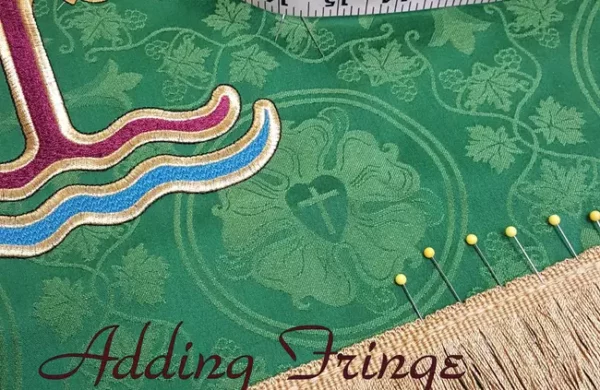
To sew fringe, you have two options. The first is using a multi-step zigzag stitch with a matching thread color. Keep the stitch width wide and length short, with zigs and zags about 1/4 inch apart. The second method involves using an edge foot for straight stitching. Adjust the needle position to stitch about 3/16″ from the fringe’s edge, and guide the fringe along the edge foot for straight and even stitches. Sew slowly to maintain precision.
Like this:
Like Loading...

My recommendation, to begin with, is the 4 1/2-inch pastoral stole. It is a basic stole and a great place to begin your stole-making journey. And if you get hooked on making stoles, this a great pattern to have in your library. It is one of our most popular stoles.
Like this:
Like Loading...
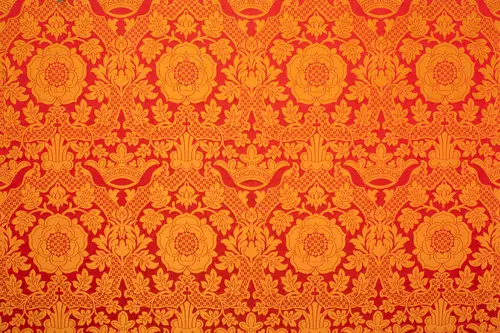
The religious brocade that we are considering today is the regal St. Margaret Liturgical Brocade fabric. This is a fabric created for use in church vestments. The design is masterfully created around the motifs of a large Tudor Rose and a Crown. Both are interspersed with vines and other floral motifs which create the impression of a large and grand pattern.
Like this:
Like Loading...

The Five Day Conference Includes several different Course Offerings: Beginning Stole Making, Advanced Stole Making, Pulpit Falls, and Monastic Chasubles. Most students will start with the Beginning Stole Making Course and move on to the Advanced Stole Making or Pulpit Falls. Course Details, kit fees, and other pertinent information are available on the conference website.
Like this:
Like Loading...
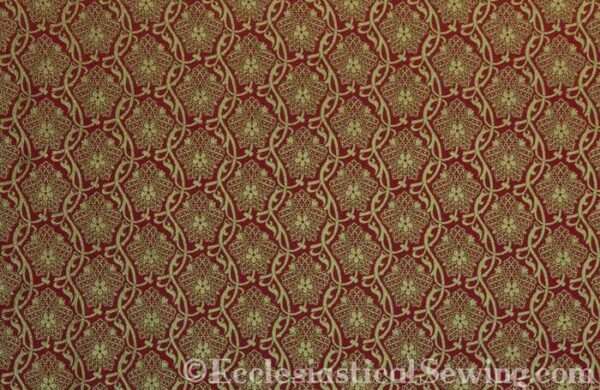
St. Hubert, designed by Sir Ninian Comper, was first produced as a liturgical fabric pattern circa 1890. This design has been recently reintroduced on a church fabric and is still lovely for use in making church vestments. As with most of Comper’s textiles, the inspiration for St. Hubert is of Netherlandish origin. This work comes from a 15th-century painting from the exhumation of St. Hubert. The fabric, made from a blend of cotton, silk, and metallic fibers, shimmers with accents of gold. While St. Hubert has a predominant right side, the fabric is also suitable for use on the “reverse” side, which makes for interesting design options
Like this:
Like Loading...
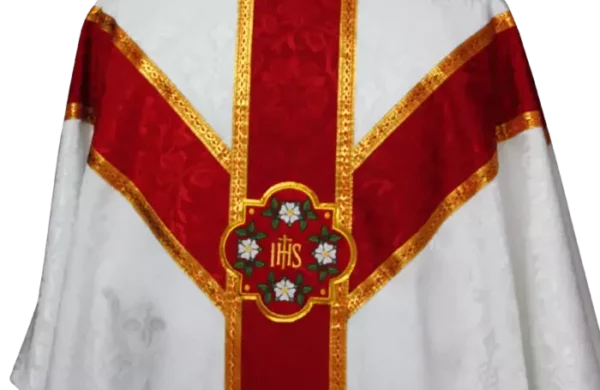
The Gothic Chasuble pattern body is a delight to sew, The pattern is printed as a full-size pattern on a large white document pattern. The chasuble pattern comes as a multi sized pattern with a small, medium, and large size. There are markings on the pattern showing placement for the “Y” orphrey bands at the shoulders. The “Y” orphrey bands are full-sized patterns. The pattern also has neckline-facing pieces.
Like this:
Like Loading...
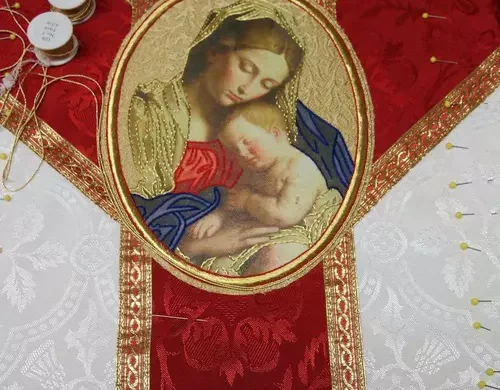
The Madonna and Child Goldwork Emblem is to be used on the back of a white Gothic chasuble. The chasuble is designed using our classic Gothic Chasuble Pattern cut with “Y” orphrey bands. The Virgin and Child design uses goldwork embroidery and colored thread embroidery embellishments on a hand-painted design. This Embroidery Design has a great deal of detailed work and requires care when applying it to a church vestment.
Like this:
Like Loading...
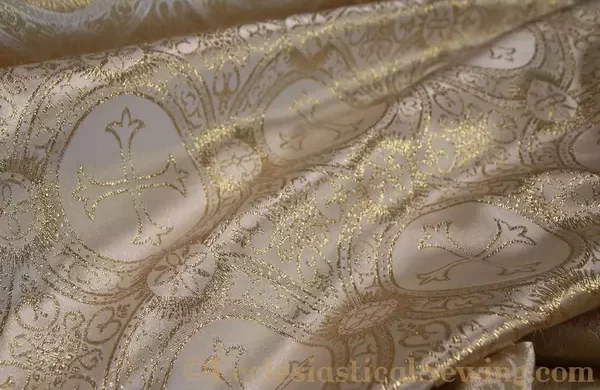
Ecclesiastical Sewing offers a special collection of white and gold liturgical fabrics for Lent and Good Friday. With unique patterns, including crosses and shimmering lurex threads, these fabrics are ideal for making chasubles, copes, altar hangings, and banners. The limited-time collection is perfect for churches with budget and provides an opportunity to create beautiful vestments for the seasons of the liturgical calendar.
Like this:
Like Loading...

Featuring our beautiful violet stole and chasuble sets for Lent and Advent. They’re carefully made with rich Fairford brocade, perfect for church seasons. The St. Irenaeus Collection offers elegant Gothic and Monastic options.
Like this:
Like Loading...
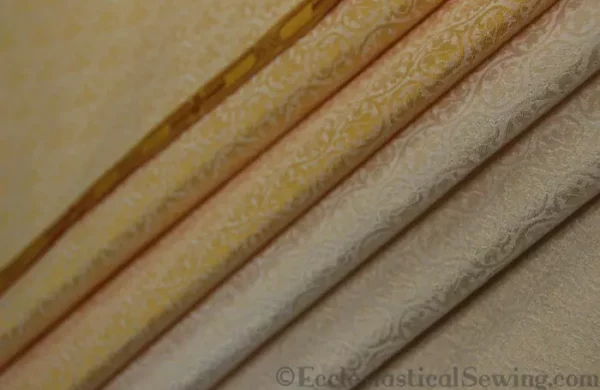
The fabrics can be a range of tapestry fabrics such as the stunning Aragon Tapestry with its large Jardinière design, Brocatelles such as Wakefield or Evesham Liturgical fabric. These are all lovely fabrics that can be used to make an entire vestment, or they can be cut and used for accents on other vestments. The size and scale of each of these fabrics allow for limitless options to fuel one’s imagination. These fabrics has shimmering threads woven into the intricate designs which adds so much to the beauty of the final vestments.
Like this:
Like Loading...
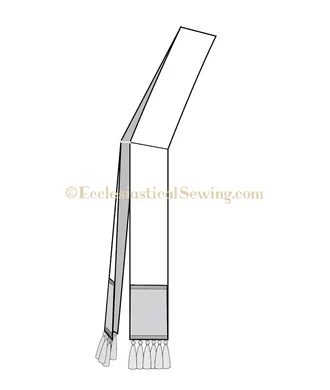
The deacon stole pattern is no more difficult to make than a pastoral or clergy stole. The deacon stole sewing pattern has mitered seams at the shoulder and waist. It uses two pattern pieces: one for the top and one for the bottom of the stole. There are also separate pattern pieces for the interfacing and lining. The pattern allows for a 5/8” seam. A variety of cross appliques can be used on the shoulder seam. Whichever cross is chosen, will have a prominent display when the vestment is worn. Tassels or fringe may be applied at the bottom of the deacon stole, just as with the clergy stoles
Like this:
Like Loading...
















You must be logged in to post a comment.